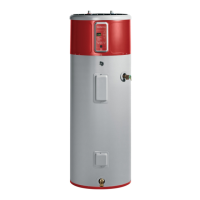– 44 –
Drain Valve
Repair or replacement of the drain valve should be
performed by a licensed plumber.
The drain valve, located at the front bottom of the
tank, has a standard garden hose tting. After
attaching an appropriate length hose, use a at
blade screwdriver to open the valve.
The use and care manual recommends the
consumer drain several quarts of water from the
tank every month to prevent sediment buildup in
the bottom of the tank.
Drain Valve
If ushing the tank, disconnect power, but leave the
water supply turned on. The ow of cold water into
the tank helps to stir the sediment at the bottom
and force it out through the drain hose.
If replacing a heating element or pressure relief
valve, disconnect power, turn off the water supply,
and open a faucet somewhere in the home. Drain
the tank to the appropriate level and make the
necessary repair.
Note: When ushing or draining the tank, always
allow water to ow for several minutes at a tub
faucet after the repair. This will help to purge any
air from the system and remove any stirred-up
sediment that could clog other home faucets that
contain screens.
Temperature Sensors
Sensor Description Normal
temperature
range
Resistance
range in
ohms
Resistance
at 77°F
T2 Tank
30°F -
160°F
34K -
1.75K
10K
T3a Evaporator
inlet
15°F -
130°F
57K - 3K 10K
T3b Evaporator
outlet
15°F -
130°F
57K - 3K 10K
T4 Compressor
outlet
30°F -
250°F
188K - 2K 55K
T5 Ambient
15°F -
130°F
57K - 3K 10K
Note: Sensor resistance value is continuously
provided to the main control. To accurately test
a sensor, measure its resistance value at room
temperature.
Element Covers
The upper element cover must be removed to
access the T2 tank sensor, thermal cutout (TCO), and
the upper element. (See
Component Locator Views.)
The lower element cover must be removed to
access the lower element. (See Component Locator
Views.)
Each cover is attached with two T20H Torx security
screws. The Styrofoam insulation under the upper
element cover pulls straight out.
(Continued Next Page)
Styrofoam Insert
Element Cover
Temperature Sensors
The water heater has ve sensors. Four of the
sensors provide the control with sealed system
information. The T2 sensor provides information on
the tank temperature.
All sensors have a negative coefcient resistance.
As the temperature increases, the resistance value
decreases.

